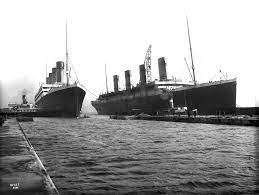
Mike Guilfoyle, vice-chair of the Friends of Brockley and Ladywell Cemeteries, discovers that Ladywell Heights was the site of Alfred Graham & Co’s St Andrew’s Works, Crofton Park’s biggest factory in the 1920s and the maker of the Titanic’s loudspeakers.
I have often had occasion to walk to Blythe Hill past an easy to miss housing development that I had until recently assumed had been built on bomb ruins from WW2. The development is called’ Ladywell Heights’ , which given the panoramic views from atop Blythe Hill nearby seems most appropriate.
But it was only when I had the opportunity to enjoy the splendid company of the founders of the Crofton Park History group at one of their monthly Drop -Ins at Crofton Park library ( https://www.croftonparkhistory.com/news-events ) I discovered that the original site had indeed an impressive industrial lineage and a fascinating but an important link to the British passenger ship, operated by the White Star Line, RMS (Royal Mail Ship) Titanic .
The 110th anniversary of the sinking of this majestic ship, the largest ship ever built at the time, deemed ‘ unsinkable’, on its maiden voyage from Southampton to New York after colliding with an iceberg on the night of April 14 1912 is almost upon us.
Of the 2,208 people on board, only 712 were saved. The rest perished in the icy-cold waters of the North Atlantic, and the tragedy has fascinated and perplexed the world ever since.*
I am crediting this history of Alfred Graham & Co (other partners being Edward Alfred Graham, and Joseph Arthur Lovel Dearlove) and its St Andrew’s Works, Crofton Park’s and the area’s first major employer from 1890s-1920s, to research undertaken by local historian Carol Harris.
I was amazed to discover that the loudspeaker phones on the Titanic were supplied by Alfred Graham and Company and installed in some of the noisier areas of the liner such as the boiler and engine rooms.

Alfred Graham and Co and the St Andrew’s Works: From 1894 until 1928, the largest employer in Crofton Park was the electrical engineering factory of Alfred Graham and Co., which began by designing and making loudspeakers and telephones for shipping.
Graham’s was at the forefront during these early days of the telecommunications industry. By 1911, the company was advertising ‘Alfred Graham and Co’s patent loud-speaking naval telephones, as adopted by the British Admiralty, many foreign governments and the leading steamship lines.’
Graham’s Navy phones were used on Britain’s new Dreadnought class of battleships, and the new Australian Navy’s heavy cruiser HMAS Australia. They were also installed on luxury liners such as the Olympic and Titanic. Phones in the liners’ cabins could be supplied silver plated.
The factory address, found on much of its equipment, was St Andrew’s Works, Crofton Park, SE4 – the site is the turn off on Crofton Park Road which today is known as Ladywell Heights.
By the outbreak of the First World War (1914), Graham’s specialities were ‘loud speaking telephones, exchange switchboards and other apparatus for communication on board war and mercantile vessels, for use in power stations, mines, collieries etc.’ The arrival of the motor car presented another opportunity for innovation and soon the company was producing the Graham Electrical Auto horn which, their advertisement promised, ‘warns but does not worry’.

By 1920, records and the radio began to replace the piano as home entertainment. A new company, ‘Graham Amplion Ltd.’ was established with the same Crofton Park address, producing loudspeakers for wireless sets, gramophones and radiograms. By this time, 300 staff were employed at the St Andrew’s works.
At the 1922 British Industries Fair, the company exhibited as manufacturers of ‘Gramophones of quality and distinction (Algraphones); Spring Motors; “Sonat” Sound Boxes; Record Filing System; also Gramophone Components and Accessories.
The company continued to innovate throughout the 1920s, developing public address systems and, especially, introducing the Totalisator (Tote) to British racetracks. Given their pioneering reputation, it is no surprise that Alfred Graham was one of the early shareholders in the British Broadcasting Company – the forerunner of the BBC.

In 1928, Graham’s moved to another, much larger factory, in Slough, Berkshire, and the St Andrew’s Works was put up for sale. A surveyor’s report In May that year remarked on the prime location of the one-acre site, “about five minutes’ walk from Crofton Park station with its electric train service…buildings of good modern construction, substantially built brick and slated roofs. The works comprise several spacious and well-lighted workshops; the whole premises having floor space of about 30,000 square feet… The offices are commodious and well fitted; excellent lavatory and sanitary accommodation is provided, both to offices and factory. ( Included are two dwelling houses. 94 and 96 Crofton Park Road.’) Source – Carol Harris , Crofton Park History -Telephones on the Titanic’ (2018)
Alfred Graham and Company merit a well deserved place on Graces Guide to British Industrial History – https://www.gracesguide.co.uk/Alfred_Graham_and_Co
Alfred Graham who had resided at ‘Irongates’ Dacre road, Forest Hill , Lewisham died in 1929 and was interred in Camberwell Old Cemetery on the 15 April of that year.
As with the Ladywell Inventor Alfred Charles Brown (featured on an earlier post) -maybe this Alfred might be another candidate for a Maroon plaque during Lewisham’s Borough of Culture?
* John Sealby Ismay ( d.1920 ) who is buried in Hither Green cemetery was the uncle of Joseph Bruce Ismay ( played by Jonathan Hyde in James Cameron’s 1997 film Titanic) J. Bruce Ismay was the highest-ranking White Star official to survive the sinking of the company’s flagship RMS Titanic, for which he was subject to severe criticism.
